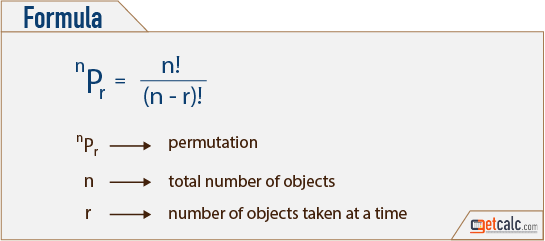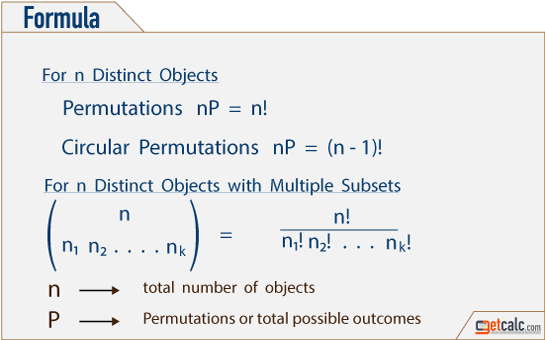Total Possible Outcomes - Permutation (nPr) Calculator
getcalc.com's Permutation (nPr) calculator, formula, solved examples to estimate how many number of possible ways r objects taken at a time from n distinct objects or to find the total sample space elements in statistical experiments where the order of objects is important.
| nPr | Permutations |
|---|---|
| 3P2 | 6 |
| 5P2 | 20 |
| 6P5 | 720 |
| 13P4 | 17,160 |
| 10P7 | 604,800 |
What is Permutation (nPr)?
Permutations is a mathematical function or method often denoted by (nPr) or nPr in the context of probability & statistics, represents how many number of possible ways r objects taken at a time from n distinct objects in statistical experiments where the order of objects is having much significance. It's one of the most widely used functions in statistics & probability to find the total sample space elements or the total number of possibilities. Since the order of elements is very important in nPr, the partial outcomes of sample space or the order of elements AB & BA are not same in permutations and counted as two different outcomes, for taking 2 objects from 3 distinct objects A, B & C at a time. These two events AB & BA are considered as same in predicting (nCr) Combinations, since the order of elements is not important. The number of permutations for r objects from n distinct objects is denoted by nPr. The number of possible outcomes or Permutations is reduced, if n objects have identical or indistinguishable objects. For example, 9P3 or 9P3 or 9P3 denotes the Permutation of 3 objects taken at a time from group of 9 objects. Use this Permutation (nPr) calculator to find the total possible ways to choose r objects from n objects, at a time to estimate the total possible outcomes of sample space in probability & statistics surveys or experiments.
One of the popular applications of permutations is to find how many distinct ways to arrange n letters. To shuffle all the alphabets in a word, supply the total number of letters in a word as n for total number of elements and n as r for taking any n elements at a time. Therefore the number of permutations is n!.
Users may use the second formula to find the nPr value for group having similar elements or different set of subsets. Refer this example of finding how many ways to arrange the letters of word "STATISTICS" having different subset to understand how the permutations be used in two different cases or use number of ways to arrange a word calculator to execute similar word problems.
nPr Formulas
The below formulas are the mathematical representations of permutations. User may use the corresponding formula according to the test scenario or use the nPr calculator to find the total number of ways for r objects taken at a time from n distinct objects.

nPr Solved Examples
Users may refer the following solved examples to know where the permutations be used in statistical experiments and how to find it. Users also try this permutations (nPr) calculator to verify your test results when users practicing permutations with different dataset.
Use any one of the below formulas based on your dataset.
nPr for n distinct objects = n!
nPr for n distinct objects in a circle = (n - 1)!
Objects r taken at a time from n distinct objects nPr = n!/(n - r)!
nPr for group of objects with multiple subsets n1, n2, . . . , nk groups = n!/(n1!, n2!, . . . , nk!)
Example Problem
How many number of possible ways 2 candidates of 5 women be selected as group leaders?
Solution
Step by step workout
step 1 Arrange the data for computation
Total number of women
n = 5
r taken at a time = 2
step 2 Find the corresponding Permutations formula.
The formula to find the number of permutations
nPr = n!/(n - r)!
step 3 apply the values in the formula
5P2 = 5!/(5 - 2)!
= 5!/3!
= (1 x 2 x 3 x 4 x 5)/(1 x 2 x 3)
= (4 x 5)
= 20
In 20 distinct ways, the 2 women be selected as group leaders from 5 women.
Example Problem
In how many ways a group of 7 students be arranged to sit in 2 two seated desk and 1 three seated desk.
Solution
Step by step workout
step 1Arrange the data for computation
Total number of students n = 7
Number of subsets n1, n2 & n3 = (2, 2 & 3)
where,
n1 = 2
n2 = 2
n3 = 3
step 2 Find the corresponding Permutations formula.
The formula to find the number of permutations for 7 students of subset n1 = 2, n2 = 2 & n3 = 3
n!/(n1!, n2!, . . . , nk!)
step 3 apply the values in the formula
= 7!/(2! 2! 3!)
= (1 x 2 x 3 x 4 x 5 x 6 x 7)/{(1 x 2) (1 x 2) (1 x 2 x 3)}
= (5 x 6 x 7)
= 210
In 210 distinct ways, the 7 students be seated in 2 two seated desk & 1 three seated desk.
Example Problem
How many distinct ways a word of "CALCULATOR" can be arranged?
SolutionStep by step workout
step 1 Arrange the data for computation
Total number of alphabets in the word "CALCULATOR"
n = 9
C = 2; A = 2; L =2; U, T, O & R = 1
step 2 Find the corresponding Permutations formula.
The formula from the above formulas to find the number of permutations for a word "CALCULATOR" with the subset of n1(C) = 2, n2(A) = 2, n3(L) = 2, n4(U) = 1, n5(T) = 1, n6(O) = 1 & n7(R) = 1
step 3 Apply the values in the formula
= 9!/(2! 2! 2! 1! 1! 1! 1!)
= (1 x 2 x 3 x 4 x 5 x 6 x 7 x 8 x 9)/{(1 x 2) (1 x 2) (1 x 2) (1) (1) (1) (1)}
= (5 x 6 x 7 x 8 x 9)
= 45,360
In 45360 distinct ways, the letters of word "CALCULATOR" can be arranged.
User may use this nPr calculator, formula & solved example problems to learn & practice or verify the calculations of total possible elements of sample space in statistical experiments.

